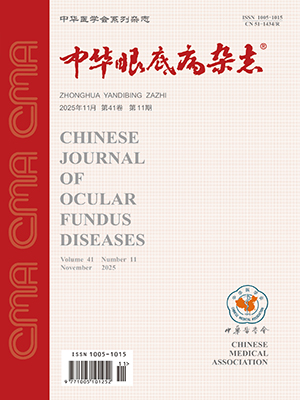| 1. |
Hilton G, Grizzard W. Pneumatic retinopexy. A two-step outpatient operation without conjunctival incision[J]. Ophthalmology, 1986, 93(5): 626-641. DOI: 10.1016/s0161-6420(86)33696-0.
|
| 2. |
Hillier RJ, Felfeli T, Berger AR, et al. The pneumatic retinopexy versus vitrectomy for the management of primary rhegmatogenous retinal detachment outcomes randomized trial (PIVOT)[J]. Ophthalmology, 2019, 126(4): 531-539. DOI: 10.1016/j.ophtha.2018.11.014.
|
| 3. |
Stewart S, Chan W. Pneumatic retinopexy: patient selection and specific factors[J]. Clin Ophthalmol, 2018, 12: 493-502. DOI: 10.2147/opth.S137607.
|
| 4. |
王文吉. 孔源性视网膜脱离的手术选择[J]. 中国眼耳鼻喉科杂志, 2003, 3(2): 73-75. DOI: 10.3969/j.issn.1671-2420.2003.02.002.Wang WJ. Selection of operations for rhegmatogenous retinal detachment[J]. Chin J Ophthalmol and Otorhinolaryngol, 2003, 3(2): 73-75. DOI: 10.3969/j.issn.1671-2420.2003.02.002.
|
| 5. |
Huang CY, Mikowski M, Wu L. Pneumatic retinopexy: an update[J]. Graefe's Arch Clin Exp Ophthalmol, 2022, 260(3): 711-722. DOI: 10.1007/s00417-021-05448-x.
|
| 6. |
Yannuzzi NA, Li C, Fujino D, et al. Clinical outcomes of rhegmatogenous retinal detachment treated with pneumatic retinopexy[J]. JAMA Ophthalmol, 2021, 139(8): 848-853. DOI: 10.1001/jamaophthalmol.2021.1860.
|
| 7. |
Sebag J, Tang M. Pneumatic retinopexy using only air[J]. Retina, 1993, 13(1): 8-12. DOI: 10.1097/00006982-199313010-00003.
|
| 8. |
李恩辉, 张昕, 张芦燕, 等. 改良式充气性视网膜固定手术治疗单纯性孔源性视网膜脱离的临床观察[J]. 中华眼底病杂志, 2021, 37(1): 54-56. DOI: 10.3760/cma.j.cn511434-20200729-00360.Li EH, Zhang X, Zhang LY, et al. Clinical observation of modified pneumatic retinopexy for primary rhegmatogenous retinal detachments[J]. Chin J Ocul Fundus Dis, 2021, 37(1): 54-56. DOI: 10.3760/cma.j.cn511434-20200729-00360.
|
| 9. |
Sinawat S, Ratanapakorn T, Sanguansak T, et al. Air vs perfluoropropane gas in pneumatic retinopexy: a randomized noninferiority trial[J]. Arch Ophthalmol, 2010, 128(10): 1243-1247. DOI: 10.1001/archophthalmol.2010.230.
|
| 10. |
Modi YS, Townsend J, Epstein AE, et al. Pneumatic retinopexy for retinal detachment occurring after prior scleral buckle or pars plana vitrectomy[J]. Ophthalmic Surg Lasers Imaging Retina, 2014, 45(5): 409-413. DOI: 10.3928/23258160-20140909-05.
|
| 11. |
Petrushkin HJ, Elgohary MA, Sullivan PM. Rescue pneumatic retinopexy in patients with failed primary retinal detachment surgery[J]. Retina, 2015, 35(9): 1851-1859. DOI: 10.1097/IAE.0000000000000546.
|
| 12. |
Rootman DB, Luu S, M Conti S, et al. Predictors of treatment failure for pneumatic retinopexy[J]. Can J Ophthalmol, 2013, 48(6): 549-552. DOI: 10.1016/j.jcjo.2013.05.002.
|
| 13. |
Hilton GF, Tornambe PE. Pneumatic retinopexy. An analysis of intraoperative and postoperative complications. The Retinal Detachment Study Group[J]. Retina, 1991, 11(3): 285-294. DOI: 10.1097/00006982-199111030-00003.
|
| 14. |
Baker SR, Hainsworth DP. Suprachoroidal gas as a complication of pneumatic retinopexy[J]. Retina, 2000, 20(2): 224-225. DOI: 10.1097/00006982-200002000-00025.
|
| 15. |
Goldman DR, Shah CP, Heier JS. Expanded criteria for pneumatic retinopexy and potential cost savings[J]. Ophthalmology, 2014, 121(1): 318-326. DOI: 10.1016/j.ophtha.2013.06.037.
|




